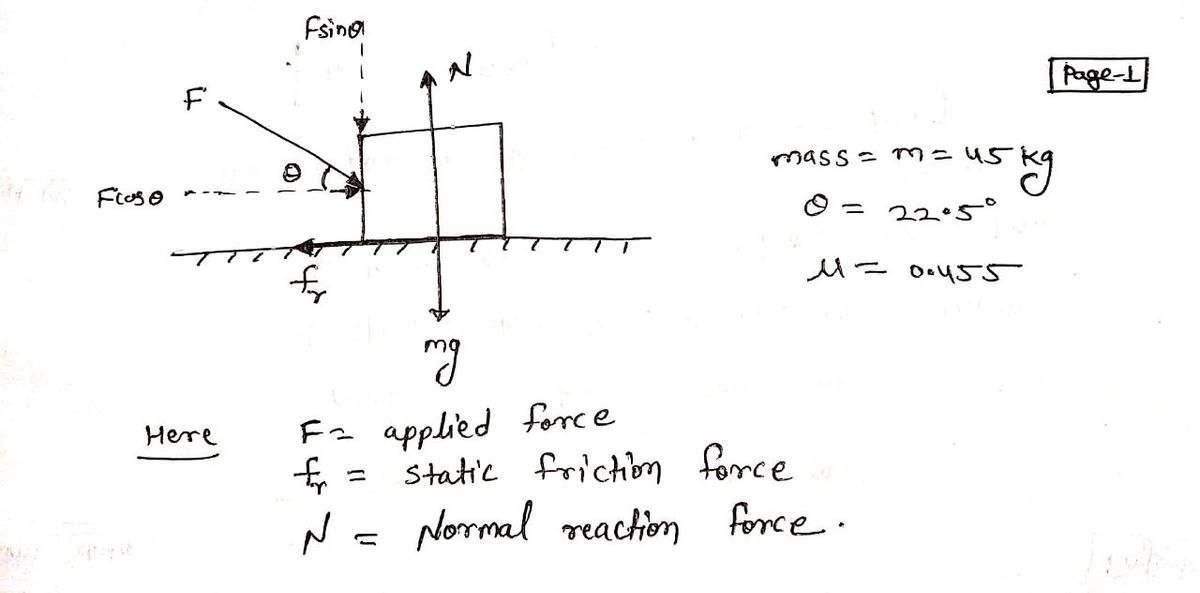2. A worker pushes a 45.0-kg crate across a rough factory floor. The crate is very short, so the worker has to bend down to push on it, causing her to push down at an angle of 22.5° from horizontal. If the coefficient of static friction between the crate and the floor is 0.455, how big of a force is needed to start the crate moving?
2. A worker pushes a 45.0-kg crate across a rough factory floor. The crate is very short, so the worker has to bend down to push on it, causing her to push down at an angle of 22.5° from horizontal. If the coefficient of static friction between the crate and the floor is 0.455, how big of a force is needed to start the crate moving?
College Physics
11th Edition
ISBN:9781305952300
Author:Raymond A. Serway, Chris Vuille
Publisher:Raymond A. Serway, Chris Vuille
Chapter1: Units, Trigonometry. And Vectors
Section: Chapter Questions
Problem 1CQ: Estimate the order of magnitude of the length, in meters, of each of the following; (a) a mouse, (b)...
Related questions
Topic Video
Question
![**Problem 2: Calculating the Force Needed to Start Moving a Crate**
A worker attempts to push a 45.0-kg crate across a rough factory floor. The crate's short height forces the worker to adopt a bent posture, resulting in a downward push at an angle of 22.5° from the horizontal plane. The coefficient of static friction between the floor and the crate is measured at 0.455. Determine the magnitude of the force required to initiate movement of the crate.
### Analysis:
To solve this problem, consider the forces acting on the crate:
1. **Weight**: The gravitational force acting downwards on the crate, calculated as mass (m) multiplied by gravitational acceleration (g = 9.81 m/s²).
2. **Normal Force**: The perpendicular force exerted by the floor on the crate.
3. **Applied Force**: The force applied by the worker, which has both horizontal and vertical components due to the angle.
4. **Static Frictional Force**: The resistive force preventing the crate from moving, calculated using the coefficient of static friction (μ_s) and the normal force.
### Approach:
1. **Calculate the Weight**:
\[
F_{\text{gravity}} = m \times g = 45.0 \, \text{kg} \times 9.81 \, \text{m/s}^2
\]
2. **Resolve the Applied Force into Components**:
- Horizontal component (\(F_{\text{x}}\)): \(F \cos(22.5^\circ)\)
- Vertical component (\(F_{\text{y}}\)): \(F \sin(22.5^\circ)\)
3. **Determine the Normal Force**:
- Normal force is adjusted by the vertical component of the applied force:
\[
N = F_{\text{gravity}} - F_{\text{y}}
\]
4. **Calculating Static Friction**:
- Static friction \(F_{\text{friction}}\) is given by:
\[
F_{\text{friction}} = \mu_s \times N
\]
5. **Setting Up the Equation**:
- To start the movement, the horizontal component of the applied force must overcome the static friction. Therefore:
\[
F_{\text{x}} = F_{\text{friction}}
\](/v2/_next/image?url=https%3A%2F%2Fcontent.bartleby.com%2Fqna-images%2Fquestion%2F278fbf48-8175-4c44-ac0e-2265809c567f%2F3bdbda67-ee7d-4659-aefb-2b823d42bde1%2Fjs5s3r_processed.png&w=3840&q=75)
Transcribed Image Text:**Problem 2: Calculating the Force Needed to Start Moving a Crate**
A worker attempts to push a 45.0-kg crate across a rough factory floor. The crate's short height forces the worker to adopt a bent posture, resulting in a downward push at an angle of 22.5° from the horizontal plane. The coefficient of static friction between the floor and the crate is measured at 0.455. Determine the magnitude of the force required to initiate movement of the crate.
### Analysis:
To solve this problem, consider the forces acting on the crate:
1. **Weight**: The gravitational force acting downwards on the crate, calculated as mass (m) multiplied by gravitational acceleration (g = 9.81 m/s²).
2. **Normal Force**: The perpendicular force exerted by the floor on the crate.
3. **Applied Force**: The force applied by the worker, which has both horizontal and vertical components due to the angle.
4. **Static Frictional Force**: The resistive force preventing the crate from moving, calculated using the coefficient of static friction (μ_s) and the normal force.
### Approach:
1. **Calculate the Weight**:
\[
F_{\text{gravity}} = m \times g = 45.0 \, \text{kg} \times 9.81 \, \text{m/s}^2
\]
2. **Resolve the Applied Force into Components**:
- Horizontal component (\(F_{\text{x}}\)): \(F \cos(22.5^\circ)\)
- Vertical component (\(F_{\text{y}}\)): \(F \sin(22.5^\circ)\)
3. **Determine the Normal Force**:
- Normal force is adjusted by the vertical component of the applied force:
\[
N = F_{\text{gravity}} - F_{\text{y}}
\]
4. **Calculating Static Friction**:
- Static friction \(F_{\text{friction}}\) is given by:
\[
F_{\text{friction}} = \mu_s \times N
\]
5. **Setting Up the Equation**:
- To start the movement, the horizontal component of the applied force must overcome the static friction. Therefore:
\[
F_{\text{x}} = F_{\text{friction}}
\
Expert Solution
Given:-

Step by step
Solved in 4 steps with 3 images

Knowledge Booster
Learn more about
Need a deep-dive on the concept behind this application? Look no further. Learn more about this topic, physics and related others by exploring similar questions and additional content below.Recommended textbooks for you

College Physics
Physics
ISBN:
9781305952300
Author:
Raymond A. Serway, Chris Vuille
Publisher:
Cengage Learning

University Physics (14th Edition)
Physics
ISBN:
9780133969290
Author:
Hugh D. Young, Roger A. Freedman
Publisher:
PEARSON

Introduction To Quantum Mechanics
Physics
ISBN:
9781107189638
Author:
Griffiths, David J., Schroeter, Darrell F.
Publisher:
Cambridge University Press

College Physics
Physics
ISBN:
9781305952300
Author:
Raymond A. Serway, Chris Vuille
Publisher:
Cengage Learning

University Physics (14th Edition)
Physics
ISBN:
9780133969290
Author:
Hugh D. Young, Roger A. Freedman
Publisher:
PEARSON

Introduction To Quantum Mechanics
Physics
ISBN:
9781107189638
Author:
Griffiths, David J., Schroeter, Darrell F.
Publisher:
Cambridge University Press

Physics for Scientists and Engineers
Physics
ISBN:
9781337553278
Author:
Raymond A. Serway, John W. Jewett
Publisher:
Cengage Learning

Lecture- Tutorials for Introductory Astronomy
Physics
ISBN:
9780321820464
Author:
Edward E. Prather, Tim P. Slater, Jeff P. Adams, Gina Brissenden
Publisher:
Addison-Wesley

College Physics: A Strategic Approach (4th Editio…
Physics
ISBN:
9780134609034
Author:
Randall D. Knight (Professor Emeritus), Brian Jones, Stuart Field
Publisher:
PEARSON